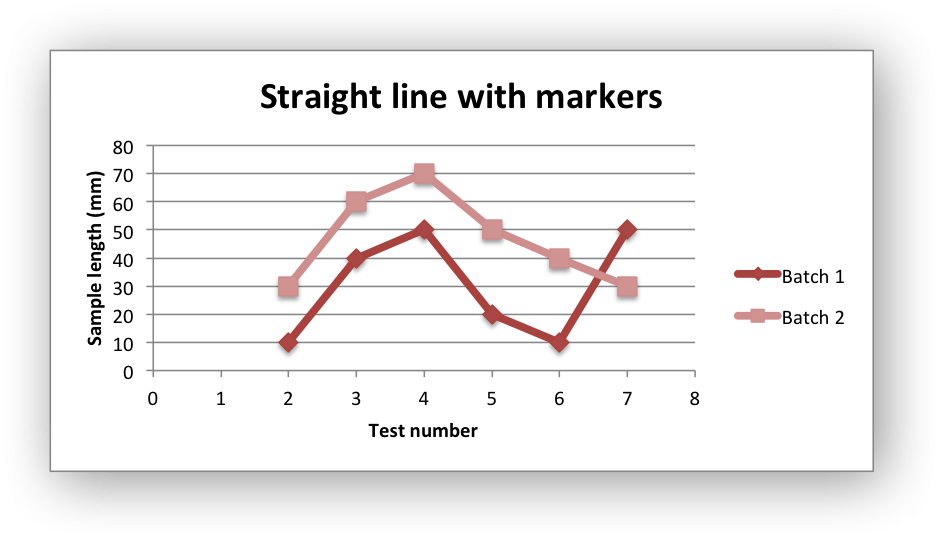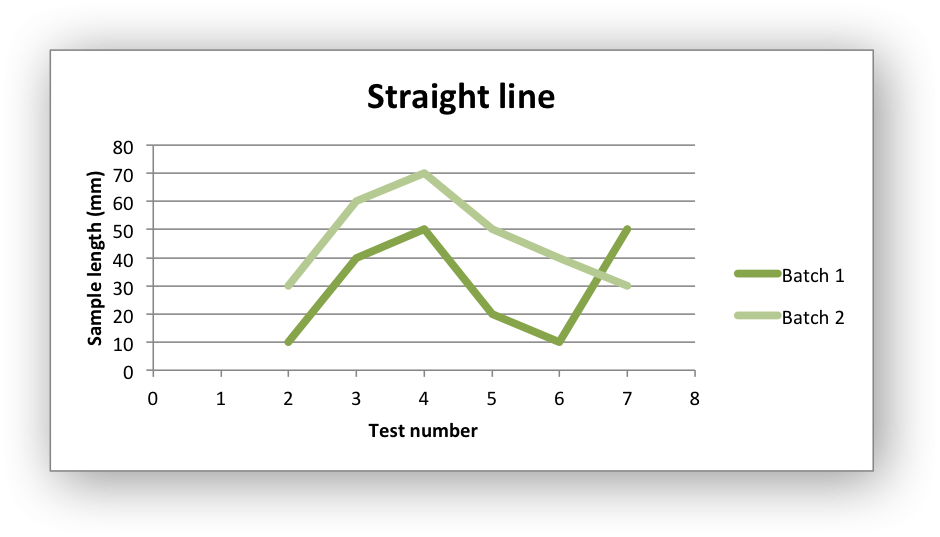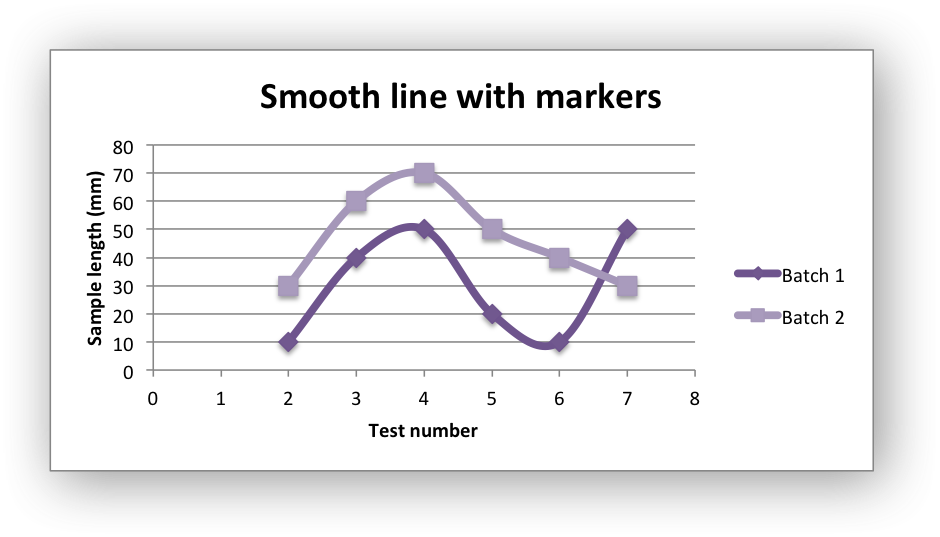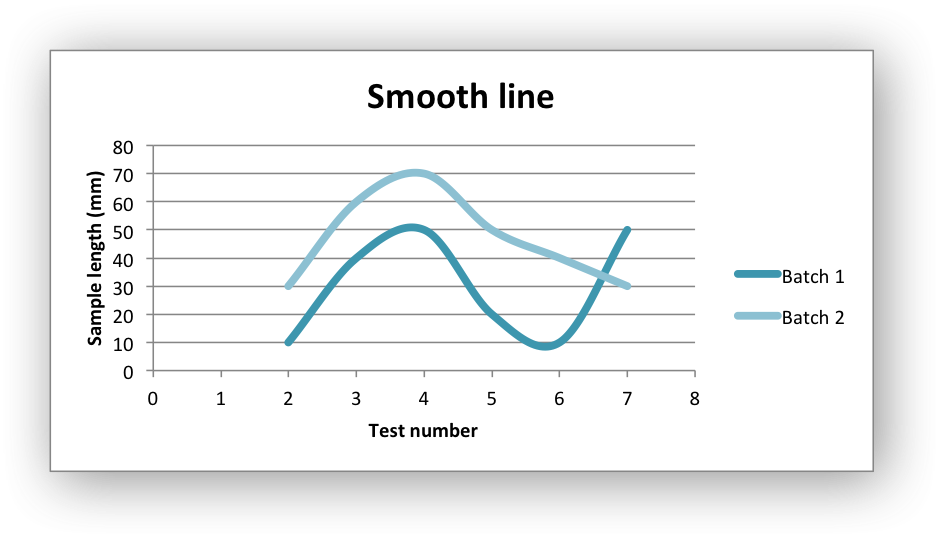Example: Scatter Chart#
Example of creating Excel Scatter charts.
Chart 1 in the following example is a default scatter chart:

Chart 2 is a scatter chart with straight lines and markers:

Chart 3 is a scatter chart with straight lines and no markers:

Chart 4 is a scatter chart with smooth lines and markers:

Chart 5 is a scatter chart with smooth lines and no markers:

#######################################################################
#
# An example of creating Excel Scatter charts with Python and XlsxWriter.
#
# SPDX-License-Identifier: BSD-2-Clause
# Copyright 2013-2024, John McNamara, jmcnamara@cpan.org
#
import xlsxwriter
workbook = xlsxwriter.Workbook("chart_scatter.xlsx")
worksheet = workbook.add_worksheet()
bold = workbook.add_format({"bold": 1})
# Add the worksheet data that the charts will refer to.
headings = ["Number", "Batch 1", "Batch 2"]
data = [
[2, 3, 4, 5, 6, 7],
[10, 40, 50, 20, 10, 50],
[30, 60, 70, 50, 40, 30],
]
worksheet.write_row("A1", headings, bold)
worksheet.write_column("A2", data[0])
worksheet.write_column("B2", data[1])
worksheet.write_column("C2", data[2])
#######################################################################
#
# Create a new scatter chart.
#
chart1 = workbook.add_chart({"type": "scatter"})
# Configure the first series.
chart1.add_series(
{
"name": "=Sheet1!$B$1",
"categories": "=Sheet1!$A$2:$A$7",
"values": "=Sheet1!$B$2:$B$7",
}
)
# Configure second series. Note use of alternative syntax to define ranges.
chart1.add_series(
{
"name": ["Sheet1", 0, 2],
"categories": ["Sheet1", 1, 0, 6, 0],
"values": ["Sheet1", 1, 2, 6, 2],
}
)
# Add a chart title and some axis labels.
chart1.set_title({"name": "Results of sample analysis"})
chart1.set_x_axis({"name": "Test number"})
chart1.set_y_axis({"name": "Sample length (mm)"})
# Set an Excel chart style.
chart1.set_style(11)
# Insert the chart into the worksheet (with an offset).
worksheet.insert_chart("D2", chart1, {"x_offset": 25, "y_offset": 10})
#######################################################################
#
# Create a scatter chart sub-type with straight lines and markers.
#
chart2 = workbook.add_chart({"type": "scatter", "subtype": "straight_with_markers"})
# Configure the first series.
chart2.add_series(
{
"name": "=Sheet1!$B$1",
"categories": "=Sheet1!$A$2:$A$7",
"values": "=Sheet1!$B$2:$B$7",
}
)
# Configure second series.
chart2.add_series(
{
"name": "=Sheet1!$C$1",
"categories": "=Sheet1!$A$2:$A$7",
"values": "=Sheet1!$C$2:$C$7",
}
)
# Add a chart title and some axis labels.
chart2.set_title({"name": "Straight line with markers"})
chart2.set_x_axis({"name": "Test number"})
chart2.set_y_axis({"name": "Sample length (mm)"})
# Set an Excel chart style.
chart2.set_style(12)
# Insert the chart into the worksheet (with an offset).
worksheet.insert_chart("D18", chart2, {"x_offset": 25, "y_offset": 10})
#######################################################################
#
# Create a scatter chart sub-type with straight lines and no markers.
#
chart3 = workbook.add_chart({"type": "scatter", "subtype": "straight"})
# Configure the first series.
chart3.add_series(
{
"name": "=Sheet1!$B$1",
"categories": "=Sheet1!$A$2:$A$7",
"values": "=Sheet1!$B$2:$B$7",
}
)
# Configure second series.
chart3.add_series(
{
"name": "=Sheet1!$C$1",
"categories": "=Sheet1!$A$2:$A$7",
"values": "=Sheet1!$C$2:$C$7",
}
)
# Add a chart title and some axis labels.
chart3.set_title({"name": "Straight line"})
chart3.set_x_axis({"name": "Test number"})
chart3.set_y_axis({"name": "Sample length (mm)"})
# Set an Excel chart style.
chart3.set_style(13)
# Insert the chart into the worksheet (with an offset).
worksheet.insert_chart("D34", chart3, {"x_offset": 25, "y_offset": 10})
#######################################################################
#
# Create a scatter chart sub-type with smooth lines and markers.
#
chart4 = workbook.add_chart({"type": "scatter", "subtype": "smooth_with_markers"})
# Configure the first series.
chart4.add_series(
{
"name": "=Sheet1!$B$1",
"categories": "=Sheet1!$A$2:$A$7",
"values": "=Sheet1!$B$2:$B$7",
}
)
# Configure second series.
chart4.add_series(
{
"name": "=Sheet1!$C$1",
"categories": "=Sheet1!$A$2:$A$7",
"values": "=Sheet1!$C$2:$C$7",
}
)
# Add a chart title and some axis labels.
chart4.set_title({"name": "Smooth line with markers"})
chart4.set_x_axis({"name": "Test number"})
chart4.set_y_axis({"name": "Sample length (mm)"})
# Set an Excel chart style.
chart4.set_style(14)
# Insert the chart into the worksheet (with an offset).
worksheet.insert_chart("D50", chart4, {"x_offset": 25, "y_offset": 10})
#######################################################################
#
# Create a scatter chart sub-type with smooth lines and no markers.
#
chart5 = workbook.add_chart({"type": "scatter", "subtype": "smooth"})
# Configure the first series.
chart5.add_series(
{
"name": "=Sheet1!$B$1",
"categories": "=Sheet1!$A$2:$A$7",
"values": "=Sheet1!$B$2:$B$7",
}
)
# Configure second series.
chart5.add_series(
{
"name": "=Sheet1!$C$1",
"categories": "=Sheet1!$A$2:$A$7",
"values": "=Sheet1!$C$2:$C$7",
}
)
# Add a chart title and some axis labels.
chart5.set_title({"name": "Smooth line"})
chart5.set_x_axis({"name": "Test number"})
chart5.set_y_axis({"name": "Sample length (mm)"})
# Set an Excel chart style.
chart5.set_style(15)
# Insert the chart into the worksheet (with an offset).
worksheet.insert_chart("D66", chart5, {"x_offset": 25, "y_offset": 10})
workbook.close()